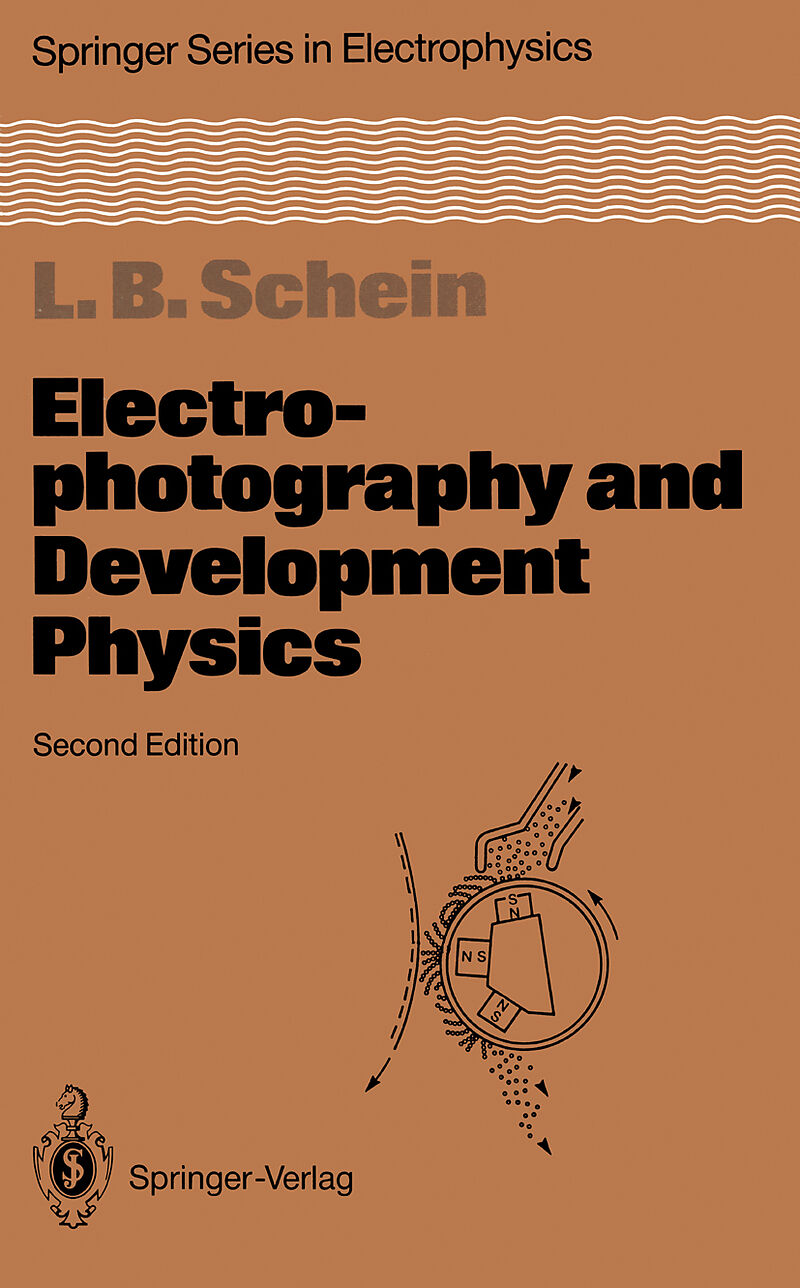Electrophotography and Development Physics
Einband:
E-Book (pdf)
EAN:
9783642777448
Autor:
Lawrence B. Schein
Herausgeber:
Springer Berlin Heidelberg
Erscheinungsdatum:
07.03.2013
Electrophotography and Development Physics focuses on the complicated and increasingly important technology found in photocopiers and laser printers. An introduction chapter acquaints the reader with the technical history of electrophotography, its current and projected markets, and also alternative related copying and printing technologies. A concise descriptionof the physics of the complete electrophotgraphic process is followed by an in-depth treatment of static electricity. The three types of developmentsystems (two component, monocomponent, and liquid), and their associated charging mechanisms. In this second edition, a discussion of the new color copiers and a chapter updating the original material have been added. On mastering this material, which is presented in a manner suitable for both the newcomer and the established expert, the reader will have a workingknowledge of the electrophotographic process and a detailed knowledge of its important subsystem, development.
Inhalt
1. Introduction.- 1.1 Technical History.- 1.2 Copier Market.- 1.3 Printer Market.- 1.4 Alternative Powder Marking Technologies.- 1.4.1 Magnetography.- 1.4.2 Ionography.- 2. The Electrophotographic Process.- 2.1 The Six Steps of Electrophotography.- 2.1.1 Charge.- 2.1.2 Expose.- 2.1.3 Develop.- 2.1.4 Transfer.- 2.1.5 Fuse.- 2.1.6 Clean.- 2.2 Implementation-Interactions.- 2.3 Subsystem Choices.- 2.3.1 Photoreceptor.- 2.3.2 Charge.- 2.3.3 Light Source.- 2.3.4 Develop.- 2.3.5 Transfer.- 2.3.6 Fuse.- 2.3.7 Clean.- 3. The Development Step.- 3.1 Challenges.- 3.2 Focus.- 3.3 Descriptions.- 4. Toner Charging for Two Component Development Systems.- 4.1 Metal-Metal Contact Charging.- 4.2 Metal-Insulator Contact Charging.- 4.2.1 Controversies.- 4.2.2 Experimental and Theoretical Difficulties.- 4.2.3 Other Metal-Insulator Experiments.- 4.2.4 Electron Transfer Theories.- 4.2.5 Ion Transfer Theories.- 4.3 Insulator-Insulator Contact Charging.- 4.4 Toner-Carrier Charging.- 4.4.1 Surface State Theory.- 4.4.2 Carbon Black.- 4.4.3 Charge Control Agents.- 4.4.4 Charge Measuring Tools.- 4.5 Summary.- 5. Cascade Development.- 5.1 Development Mechanisms.- 5.1.1 Airborne.- 5.1.2 Contact.- 5.1.3 Scavenging.- 5.1.4 Electrode Source.- 5.2 Experimental Work.- 5.2.1 Solid Area Development.- 5.2.2 Line Development.- 5.2.3 Background Development.- 5.3 Theory Ill.- 5.3.1 Airborne Development Ill.- 5.3.2 Contact Development.- 5.4 Summary.- 6. Insulative Magnetic Brush Development.- 6.1 Qualitative Comparison of Development Mechanisms.- 6.2 The Electric Field.- 6.2.1 Charges.- 6.2.2 Effective Dielectric Constant.- 6.3 Theories of Solid Area Development.- 6.3.1 Neutralization.- 6.3.2 Field Stripping.- 6.3.3 Powder Cloud.- 6.3.4 Equilibrium.- 6.3.5 Depletion.- 6.3.6 "Complete" Theory.- 6.4 Solid Area Development Experiments.- 6.5 Line Development.- 6.6 Background Development.- 6.7 Improvements.- 6.8 Summary.- 7. Conductive Magnetic Brush Development.- 7.1 Initial Theoretical Ideas.- 7.2 Experimental Data and Discussions.- 7.3 Infinitely Conductive Theory.- 7.4 Comparison with Experiment.- 7.5 Line Development.- 7.6 Background Development.- 7.7 Summary.- 8. Toner Charging for Monocomponent Development Systems.- 8.1 Induction Charging.- 8.2 Injection Charging.- 8.3 Contact Charging.- 8.4 Corona Charging.- 8.5 Charging Methods for Powder Coating.- 8.6 Other Charging Methods.- 8.7 Traveling Electric Fields.- 9. Monocomponent Development.- 9.1 Aerosol or Powder Cloud Development.- 9.2 Early Work.- 9.3 Theory of Monocomponent Development.- 9.4 Conductive Toner.- 9.5 Magnetic, Insulative Toner.- 9.6 Nonmagnetic, Insulative Toner.- 9.7 Summary.- 10. Liquid Development.- 10.1 Material Requirements.- 10.1.1 Toner Charging.- 10.1.2 Liquid Properties.- 10.2 Development Theories.- 10.2.1 First-Order Effects.- 10.2.2 Complexities.- 10.2.3 Better Development Theories.- 10.3 Toner Characteristics.- 10.3.1 Optimized Properties.- 10.3.2 Determination of Toner Properties.- 10.4 Recent Developments.- 10.5 Summary.- 11. Color Electrophotography.- 11.1 History.- 11.2 Image Quality.- 11.2.1 Grayscale.- 11.2.2 Other Challenges.- 11.3 Colored Toner Accumulation.- 11.4 New Development Systems.- 11.4.1 Image Quality.- 11.4.2 Compactness.- 11.4.3 Noncontact, Noninteracting Development System.- 11.5 Color Market.- 11.6 Current Copier Products.- 11.7 Current Printer Products.- 12. Update of Chapters 1-10.- 12-1.2 Copier Market.- 12-1.3 Printer Market.- 12-1.4 Alternative Powder Marking Technologies.- 12-1.4.1 Magnetography.- 12-1.4.2 Ionography.- 12-2.1.4 Transfer and Toner Adhesion.- 12-2.3.2 Charge.- 12-2.3.5 Transfer.- 12-2.3.7 Clean.- 12-4 Toner Charging for Two Component Development Systems.- 12-4.3 Insulator-Insulator Contact Charging.- 12-4.4 Toner-Carrier Charging.- 12-4.4.1 Surface State Theory.- 12-4.4.3 Charge Control Agents.- 12-4.4.4 Charge Measuring Tools.- 12-4.4.5 Life Characteristics.- 12-6.2.2 Effective Dielectric Constant.- 12-6.4 Solid Area Development Experiments.- 12-6.6 Background Development.- 12-7.3 Infinitely Conductive Theory.- 12-8.3 Contact Charging.- 12-9.3 Theory of Monocomponent Development.- 12-9.4 Conductive Toner.- 12-9.6 Nonmagnetic, Insulative Toner.- 12-10.1.1 Toner Charging.- 12-10.4 Recent Developments.- References.

Leider konnten wir für diesen Artikel keine Preise ermitteln ...
billigbuch.ch sucht jetzt für Sie die besten Angebote ...
Die aktuellen Verkaufspreise von 6 Onlineshops werden in Realtime abgefragt.
Sie können das gewünschte Produkt anschliessend direkt beim Anbieter Ihrer Wahl bestellen.
Loading...
Die aktuellen Verkaufspreise von 6 Onlineshops werden in Realtime abgefragt.
Sie können das gewünschte Produkt anschliessend direkt beim Anbieter Ihrer Wahl bestellen.
| # | Onlineshop | Preis CHF | Versand CHF | Total CHF | ||
|---|---|---|---|---|---|---|
| 1 | Seller | 0.00 | 0.00 | 0.00 |
